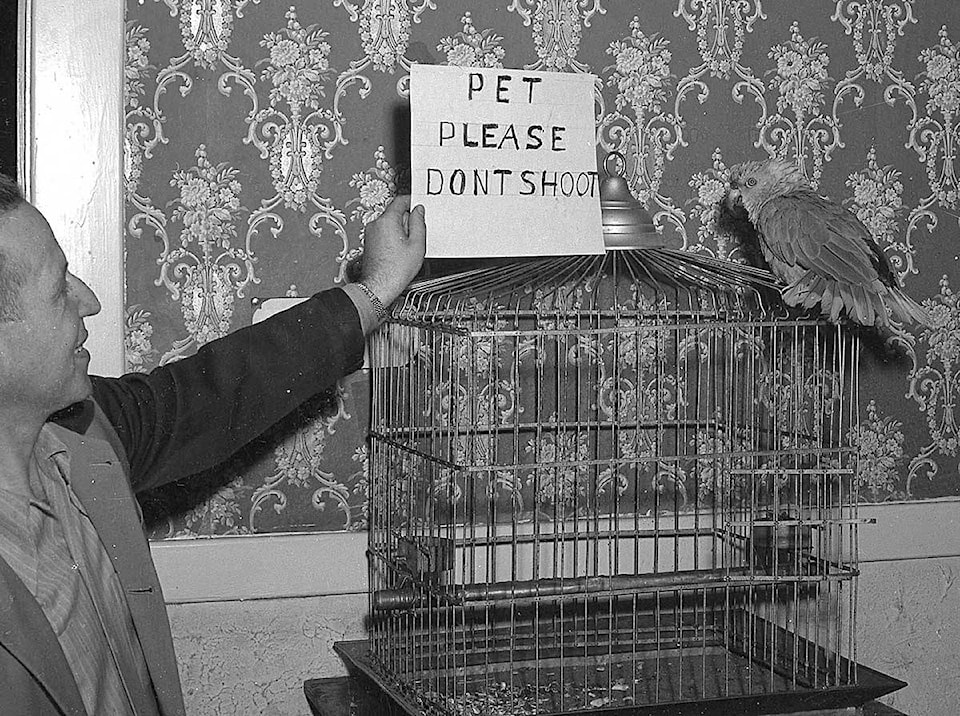Beth Boyce,
Museum at Campbell River
What do baseball playing donkeys, a cussing parrot, and a sea monster named Klamahtosaurus have in common?
All were featured in stories in The Campbell River Courier newspaper in the years 1949-1963. During this period, photographers Godfrey and May Baldwin worked with The Courier to document much of the community’s newsworthy events. The photographs clearly illustrate the changes shaping the town during a period of rapid growth and development. The upcoming exhibit at the Museum, Cover Stories: Photography by the Baldwins, showcases the newsworthy photographs, and their accompanying stories, that helped to document that time. The following are some colourful gems we uncovered while preparing the exhibit.
The 1950s saw a unique form of entertainment sweep North America: Donkey Baseball. It is exactly what it sounds like. Two teams face off in a fairly regular game of baseball; however, all players, excepting the pitcher and catcher, must do so while riding donkeys. You will be relieved to learn that the batter does not mount his donkey until after hitting the ball. The game was organized by a company out of Colorado who had a troupe of trained donkeys that they travelled with, bringing the game from town to town. In 1950 the troupe made its way to Campbell River for a fundraising event which pitted the Kinsman Club “Kookoos” against the Rotary Club “Rascals.” Over 1,400 attended the game. A hilarious play by play of the game was reported in the paper for those few who did not attend in person.
Anyone familiar with Campbell River’s history knows that there are countless colourful characters who have helped to shape this city, but did you know that the resident parrot at the Willows Hotel, Polly, was once a significant enough character to warrant having her life story recounted in the local paper? It appeared in July, 1953, in honour of her 50th birthday. The following is a brief excerpt:
Campbell River is known to tourists chiefly for its excellent sports fishing, but we’ll wager that if you asked most tourists to name the second thing that comes to mind when they think of Campbell River they’d come up with Polly, the Willows Hotel Parrot.
Old Poll isn’t what she used to be in the days when Mrs. Rowley’s Nunns’ folks bought her during the World War of 1914-18. But she is still able to give cracks and one mildly-profane phrase, namely: “Go to hell!”
Mrs. Nunns, who reckons Polly’s age as “at least 50,” says the bird used to be a wonderful talker, and able to sing a number of songs including “It’s a Long, Long Way to Tipperary.”
She’s not as lively as she used to be… but she’ll be around for quite a while yet, yelling for pancakes, whistling at the girls and advising tormentors where they can go.
In the winter of 1962, and again in 1963, many locals noticed something strange swimming in the waters of Discovery Passage. Initially reported by Alan and Mrs. Maclean, it was soon corroborated by many others who also reported seeing something out of the ordinary. In his account Maclean described it as being “16 to 18 feet long, and is a dirty ivory colour, with streaks of red shooting through it. A short distance behind its turtle-like head is a huge hump.” He went on to say, “The neck seemed to be six or eight inches though, and it was compressible. By that I mean that it lengthened or shortened as the creature thrust its head out or drew it back.” Maclean’s report launched a flurry of sightings and debate in the local papers about the existence of a Campbell River Sea Monster.
A contest was held to name the beast, who in the end was christened “Klamahtosaurus” in honour of the Indigenous name for the Campbell River Spit, at the time commonly spelt Klamahto. Sadly the Baldwin’s were not able to capture an image of the elusive creature. However, sketches and a blurry photograph taken from Quadra Island thankfully did make their way into the paper.
There are so many more details to share about these and other stories. Come to the Museum starting on January 11, 2020 to take a glimpse into our community’s colourful past.
